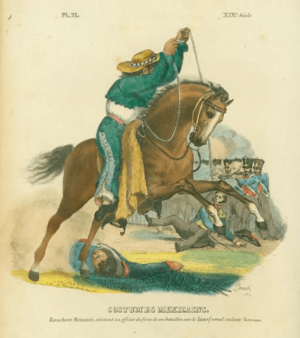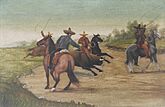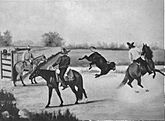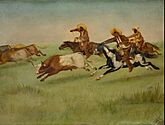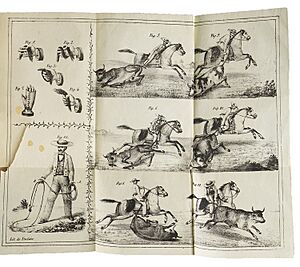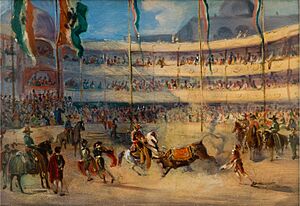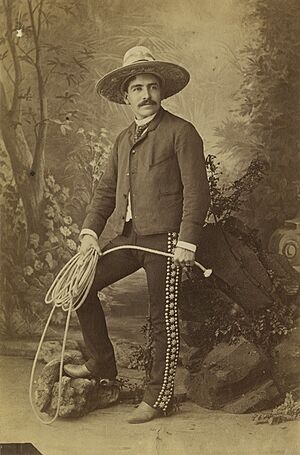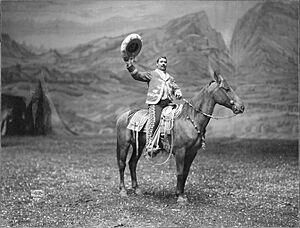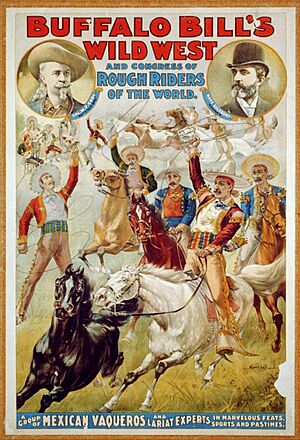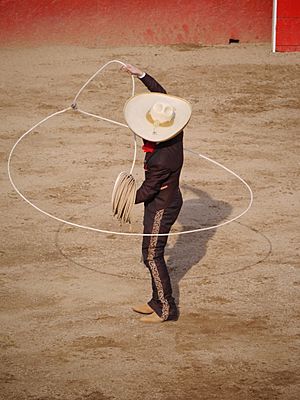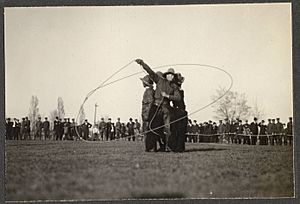Trick roping facts for kids
Floreo de reata or trick roping is a cool Mexican art form. It involves spinning a lasso, which is also called a lariat or a rope. This skill is a big part of Mexican charrería, which is like a rodeo. It's also famous from Wild West shows in the United States.
Mexican vaqueros (cowboys) used lassos to catch animals. They became very skilled at spinning and throwing ropes. Over time, they invented many tricks to show off their amazing rope skills. These tricks grew into fun shows and even competitions.
Contents
What's in a Name?
Floreo de Reata comes from two Spanish words. Floreo means "flowering" or "flourishing." Reata is a Mexican Spanish word for a rope used to catch cattle. So, Floreo de Reata means "rope flourishing." It describes making beautiful, tricky shapes with the lasso.
How Trick Roping Started
Long ago, early cowherds in the Americas used a tool called a desjarretadera. It was a lance with a curved blade. They used it to stop cattle by cutting their leg muscles. This tool was also called a "hocking knife." A vaquero on horseback would gallop behind a bull and cut its leg to stop it.
By the 1700s, roping cattle became popular across Hispanic America. But it was still very basic. People often used ropes along with the desjarretadera. The rope was just thrown without much skill. The loop didn't stay open well.
Early Rope Tricks
The first signs of Floreo de Reata, or "Trick Roping," appeared in Mexico in the late 1700s and early 1800s. Charros in western Mexico started trying new ways to use the lasso. The first written proof is from a trial in 1813. A Charro named Juan Chávez was accused of using "magic" with his lasso. People said he could rope animals without ever hurting them. He could make the lasso spin around him without closing. This was a new and amazing skill.
One big reason Mexicans developed fancy roping was the invention of the saddle-horn. This part of the saddle made it easier and safer to rope animals from horseback. Riders could wrap the rope around the saddle-horn. This helped them control the animal's speed and strength. If there was danger, they could easily let go of the rope. This invention allowed Charros to create many different throws.
Another reason was that by the early 1800s, lances and desjarretaderas were no longer used for herding cattle in Mexico. Rules were made to protect cattle and help herds grow. For example, in 1807, a count named Don Pedro Trebuesto ordered that only lassos be used. Lances caused too many injuries to the cattle. This change helped Mexican vaqueros focus on improving their roping skills. They experimented with the lasso, creating new ways to throw it. They wanted to be effective and also put on a good show.
In other parts of South America, vaqueros kept using desjarretaderas and lances for longer. Also, most of their saddles didn't have a saddle-horn. This made it harder to rope from horseback. They often had to rely on people on foot to help.
The 1800s: Roping Skills Grow
By the 1840s, Mexican roping methods were well known. They had three main parts:
Lazar: This means roping the horns or head of a bull, or the head of a horse. It can be done from horseback or on foot.
Manganear: This is roping the front legs of an animal. It can also be done from horseback or on foot. There are many different "mangana" loops, each with its own name.
Pialar: This is roping the back legs of an animal. Like manganas, "piales" can be done from horseback or on foot. Each pial loop has a special name.
Charros learned to throw the rope in any direction. They could throw it from above, below, or behind. They gave it the right spin to make the perfect loop. This helped them catch a bull or horse in any situation.
Floreo de Reata, or "Trick Roping," is really a series of these roping shots and loops. They are done one after another for artistic and showy reasons.
The first "floreados" (fancy or tricked-out) roping shots were "La Crinolina" and "La Contracrinolina." Also, the pial "La Caricia" was invented. These were created by the amazing ropers Jesús, Felipe, and Ignacio González Aragón. They were a family of Charros who worked with fighting bulls. They changed the world of roping.
Fighting bulls were very important for Mexican roping, especially trick-roping. These bulls are wilder than regular cattle. Charros who worked with them had to be very agile. They had to dodge the bulls while roping. This made them even more skilled.
In the 1860s, during the French Intervention in Mexico, Charros fought as guerrilla fighters. They used their roping skills in battle. One story tells of a Charro using "La Crinolina" to pull a general off his horse.
The first Mexican manual for roping was written by Luis G. Inclán in 1860. It was called "Rules by which a Beginner can learn Bull-Tailing and Roping." Inclán taught how to knock down a bull by its tail and how to rope. He described how to throw the lasso to get the right effect. He explained 19 different mangana loops. For example:
- La Vieja (The old one): This is the oldest and simplest mangana. You throw the lasso straight in front of the animal's front legs. You try to keep it as open as possible. When the legs enter the loop, you quickly pull your arm up to tighten the rope.
- La Salvadora (The Saviour one): This is used when the animal is running away. You just give the lasso a half-turn and throw it. It works even if the loop doesn't land perfectly.
- La Aguja (The Needle): For this, you swing the lasso backward. You throw it over the horse's back, and it lands in front of the animal's front legs.
- La Revolución (The Revolution): You throw the lasso backward like "La Aguja." But in the air, you make it spin two or three times counterclockwise. It catches the front legs on the last spin.
- La Canasta (The Basket): You throw the lasso without swinging. You make sure the rope stays open in a circle in the air. The animal steps into the loop with its front legs.
Jaripeo: The Sport of Charros
Mexican equestrian (horse riding) and bull-fighting sports have been around since the 1500s. They grew from the way ranching was done in Mexico. For a long time, these sports were mostly in the countryside. They were rarely seen in big cities.
After the French Intervention in the 1860s, Mexicans felt a strong sense of national pride. They wanted to celebrate "everything Mexican." This included Mexican horse traditions and "bullfighting" over Spanish and European ones. Even Emperor Maximilian I of Mexico admired Mexican horsemanship. He often held shows of roping and bull-riding.
Before the 1870s, Spanish-style bullfighting was most popular in Mexican cities. Mexican traditions were often just small parts of these shows. For example, picadors (bullfighters on horseback) might dress as Charros. Charros would help if a bullfighter was in danger by roping the bull.
This changed in the 1870s and 1880s. Business people and cattle ranchers promoted Mexican traditions. They showed off Jaripeo, which Spaniards called Toreo Mexicano (Mexican style Bull-fighting). Skills like roping, bull-tailing, bull-riding, and horsemanship became national sports. Jaripeo later became known as charreria in the 1900s.
Jaripeo is different from Spanish bullfights because the bulls are not killed. They are just "tormented." Spanish bullfighting came from hunting and Roman blood sports. But Jaripeo came from everyday ranch activities like herding, roping, and breaking horses. These activities didn't involve killing the animals. Jaripeo is all about showing off equestrian and cowboy skills.
Because of this, Charros focus more on skill and showmanship. That's the main goal of the sport, not killing the bull.
Great Charros became national heroes. They became famous in Mexico and other countries. Don Manuel González Aragón, from the famous González Aragón family, invented the pial (heel shot) called "El Viento." This artistic pial is used for roping bulls' heels. Don Manuel brought "El Viento" to the United States when he toured there from 1888 to 1893. Americans now call it the "Del Viento hip shot" or "Del Viento loop."
The most famous Charro roper of this time was Ponciano Díaz. He was born in 1856 at the Atenco Hacienda, a very old cattle ranch. Ponciano learned from his father, who was the captain of the vaqueros there. He became a bullfighter in 1877.
Ponciano Díaz was a superstar. People wrote songs and poems about him. In 1889, he traveled to Spain with Celso Gonzalez and Agustin Oropeza. They performed in bullrings in Madrid, showing off Mexican vaquero traditions. Mexican newspapers celebrated their success, saying they had "conquered" Spain. Thousands of people welcomed them home in Veracruz.
Trick Roping Comes to the United States
Some Mexican traditions came to the United States as Americans moved west. But many more were shared in the late 1800s. This happened thanks to American Wild West shows like Buffalo Bill's Wild West.
Floreo de Reata, or Trick Roping, was introduced to American audiences by a Charro named Vicente Oropeza. He was from Puebla, Mexico. Vicente was the brother of Agustin Oropeza, who was part of Ponciano Diaz's team that went to Spain.
Vicente Oropeza was born in 1858 on a large Hacienda. He learned his skills working with fighting bulls. He first performed in the United States in July 1891. In 1893, Vicente Oropeza led a group of 12 Charros, including Don Manuel Gonzalez Aragon, on a tour of the United States. They performed with Buffalo Bill's show in New York. Vicente Oropeza and his group worked with Buffalo Bill for 16 years.
Vicente Oropeza was named “Champion of the World” in 1900.
In 1893, when he was 13, Will Rogers saw Vicente Oropeza's roping tricks at the Chicago World's Fair. Will Rogers later said that Oropeza inspired him to become a trick roper. He called Oropeza the greatest trick roper ever.
Famous Trick Ropers
- Vicente Oropeza was the Mexican charro who brought trick roping to the United States. He is in the National Cowboy and Western Heritage Museum Hall of Fame.
- Texas Jack Omohundro was the first person to show roping acts on an American stage.
- Texas Rose Bascom was known as the "Queen of the Trick Ropers." She was in Hollywood movies and toured the world. She is in the National Cowgirl Hall of Fame.
- Montie Montana had a 60-year career as a trick roper. He was in several John Wayne movies.
- Actor and humorist Will Rogers was a cowboy and an expert trick roper. His rope tricks were shown in the 1922 silent film The Ropin' Fool. He said Vicente Oropeza inspired him.
- Vince Bruce (born 1955, died 2011) was a famous Western performer. He played Will Rogers in the Broadway musical The Will Rogers Follies. He even set a world record for "Texas Skips" in 1991.
- Flores LaDue (1883-1951) was the only cowgirl to win three world championships for trick roping. She and her husband, Guy Weadick, started the first Calgary Stampede. Flores LaDue is thought to be the first to do the Texas Skip.
- Horse trainer Buck Brannaman started his career as a child in a trick roping act with his brother.
- The English group El Granadas performed trick roping at the 1946 Royal Variety Performance.
See also


